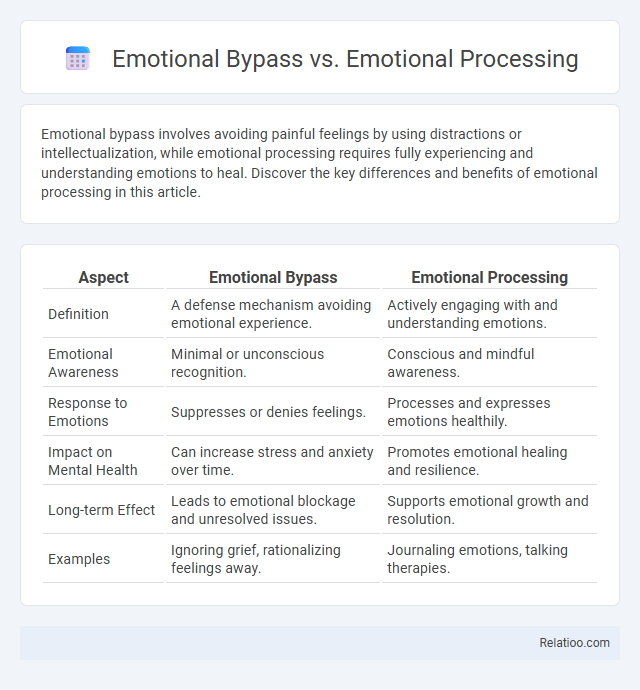Emotional bypass involves avoiding painful feelings by using distractions or intellectualization, while emotional processing requires fully experiencing and understanding emotions to heal. Discover the key differences and benefits of emotional processing in this article.
Table of Comparison
| Aspect | Emotional Bypass | Emotional Processing |
|---|---|---|
| Definition | A defense mechanism avoiding emotional experience. | Actively engaging with and understanding emotions. |
| Emotional Awareness | Minimal or unconscious recognition. | Conscious and mindful awareness. |
| Response to Emotions | Suppresses or denies feelings. | Processes and expresses emotions healthily. |
| Impact on Mental Health | Can increase stress and anxiety over time. | Promotes emotional healing and resilience. |
| Long-term Effect | Leads to emotional blockage and unresolved issues. | Supports emotional growth and resolution. |
| Examples | Ignoring grief, rationalizing feelings away. | Journaling emotions, talking therapies. |
Understanding Emotional Bypass
Emotional bypass occurs when you avoid facing painful feelings by using spiritual or intellectual strategies to stay disconnected from core emotions, hindering genuine healing. Emotional processing involves consciously experiencing and working through feelings to achieve emotional integration and resilience. Understanding emotional bypass helps you recognize unhealthy patterns that mask wounds instead of addressing and resolving them for true emotional growth.
Defining Emotional Processing
Emotional processing involves actively acknowledging, understanding, and integrating emotions to promote psychological healing and resilience. It contrasts with emotional bypass, which entails avoiding or suppressing feelings to evade discomfort, often leading to unresolved trauma. Emotional wounding refers to the initial experiences or events that cause psychological pain, serving as the root trigger for emotional responses that require processing.
Key Differences Between Bypass and Processing
Emotional bypass involves avoiding or suppressing difficult feelings by distracting oneself or rationalizing emotions, whereas emotional processing entails fully experiencing, understanding, and integrating these emotions for healing. Bypass often leads to unresolved wounds persisting beneath the surface, while processing directly addresses the root causes of emotional pain to promote genuine recovery. The key difference lies in bypass as a defense mechanism that blocks emotional awareness, contrasted with processing as an intentional engagement with emotions to transform psychological wounds.
Signs You May Be Emotionally Bypassing
Emotional bypass occurs when you avoid confronting painful feelings by focusing on positive thinking or distractions, often masking unresolved wounds instead of processing them. Signs you may be emotionally bypassing include persistent emotional numbness, overgeneralized positivity, and difficulty accessing genuine feelings during stressful situations. Recognizing these patterns enables you to engage in authentic emotional processing, leading to deeper healing and personal growth.
The Risks of Avoiding Emotional Processing
Avoiding emotional processing through emotional bypass often leads to unresolved wounds manifesting as chronic stress, anxiety, and impaired relationships. This avoidance prevents genuine healing by suppressing true feelings, which intensifies underlying emotional pain over time. Addressing wounds through emotional processing promotes resilience and psychological well-being, reducing the risk of long-term mental health issues.
Benefits of Embracing Emotional Processing
Embracing emotional processing allows individuals to confront and integrate their feelings, fostering genuine healing rather than avoidance seen in emotional bypass. This approach promotes emotional resilience by addressing wounds directly, enabling long-term mental health improvements and healthier relationships. Processing emotions openly supports self-awareness and emotional regulation, reducing the impact of unresolved trauma and promoting overall psychological well-being.
Common Triggers for Emotional Bypassing
Common triggers for emotional bypassing include intense feelings of shame, fear of vulnerability, and unresolved trauma that prompt individuals to avoid directly confronting their emotions. Emotional bypassing often arises in response to social pressures to appear strong or the belief that negative emotions are unacceptable. Recognizing these triggers is essential for shifting toward healthy emotional processing and healing deep-seated emotional wounds.
Techniques to Foster Emotional Processing
Emotional processing involves techniques such as mindfulness meditation, journaling, and cognitive-behavioral therapy that help you acknowledge and work through your feelings rather than bypassing them or suppressing wounds. Grounding exercises and somatic experiencing are effective methods to connect with bodily sensations and release stored trauma, facilitating genuine healing. Consistent practice of these approaches enhances self-awareness and emotional resilience, promoting long-term well-being and recovery from emotional wounds.
The Role of Mindfulness in Emotional Health
Mindfulness enhances emotional health by fostering awareness that differentiates emotional bypass--avoiding uncomfortable feelings--from genuine emotional processing, which involves confronting and integrating emotions for healing. Wounding creates deep emotional pain that mindfulness helps to address by encouraging presence and nonjudgmental observation, enabling Your mind to transform suffering into growth. Practicing mindfulness supports resilience and emotional clarity, making it a crucial tool in managing unresolved wounds and promoting authentic emotional well-being.
Building Resilience Through Emotional Awareness
Emotional bypass involves avoiding or minimizing feelings to escape discomfort, which hinders genuine emotional processing essential for healing wounding caused by trauma or stress. Emotional processing requires confronting and understanding emotions directly, enabling individuals to integrate experiences and build resilience by increasing emotional awareness. Developing resilience through emotional awareness strengthens coping mechanisms, reduces vulnerability to emotional wounds, and promotes psychological growth and stability.

Infographic: Emotional Bypass vs Emotional Processing
 relatioo.com
relatioo.com